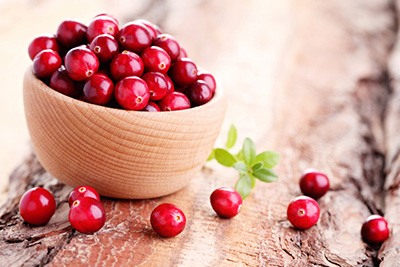 Cranberries are popular worldwide as a holiday meal accompaniment, but there are significant reasons to consider including them in your formulations as well.
Cranberries are popular worldwide as a holiday meal accompaniment, but there are significant reasons to consider including them in your formulations as well.
Cranberries are a good source of vitamin C, which makes them an excellent choice for providing antioxidant properties. These little berries also have flavonoids, phenolic acids, proanthocyanidins, anthocyanins, and a number of naturally occurring acids, including citric acid, quinic acid, benzoic acid, and malic acid.
Cranberries contain fiber, which can be extracted from the pomace made during juice pressing then dried to become a fiber ingredient. Cranberry juices or powders can be used as a colorant as well, which is a benefit of the anthocyanin content present in the berries.
Looking for cranberry products for your food formulation?
Prospector has hundreds of ingredient listings for cranberry products from global suppliers. Get ingredient data, order samples and more…
Get Ingredient Data
Despite all these great things, keep in mind that little sugar is present in cranberries, which means that they need to be sweetened or in a sweet matrix in order to be palatable.
Product formats vary widely and have varying shelf life and applications:
- Fresh cranberries have approximately a 3 month shelf-life which limits their use beyond seasonal products. These are typically used for baked goods and sauces.
- The limitation of fresh fruit is reduced with the use of frozen cranberries, which makes them available year round. They can be found in sliced forms or as a puree. This format opens them up for use in condiments, dairy products as well as baked products and sauces.
- Shelf stable products can be found in a dehydrated, sweetener or glycerin infused form, sometimes topically coated or infused with flavors to typify other fruits. These products can last up to 18 months if properly stored, and find uses in cereals, trail mix, snack foods, granola bars, dairy products, confectionery, and bakery products.
- Spray dried powders are made from cranberry juice concentrate, are very soluble, thus quite hygroscopic and have approximately 90% fruit solids. These powders can be used in teas, beverages, and confectionery products, or as a colorant.
- Juices can be found in single strength juice and concentrate, with the concentrates having more applications in formulating. These concentrates can be used as a colorant. It may have applications in dairy products, frozen confections and candies.
Some interesting regional product launches in the past year that contain cranberries may inspire you with the flavor combinations:
- A cranberry ginger energy drink launched in October 2015 during the Anuga Tech trade show in Germany.
- In the Ukraine, a wet cat food launched in October 2015. This product features Veal in cranberry sauce, and contains raisins and thyme.
- A turkey buffalo cranberry jerky launched in the US in October 2015.
- In September 2015, an apricot and cranberry porridge with pumpkin and sunflower seeds was displayed at the Specialty and Fine Food Fair in the UK.
- In the US, a triple layer orange cranberry whole milk yogurt launched in August 2015, containing cranberries and orange juice.
- In the United Arab Emirates, a spicy cranberry ice cream launched in August 2015, featuring a cranberry swirl, and cranberry-jalapeno glazed almonds. The almonds are coated with cranberry powder and dried ground jalapeno.
- In Poland, a horseradish with cranberry launched in July 15.
Be cautious when considering health claims for cranberry-based products, and fully research your country’s options. In 2014, EFSA rejected health claims submitted by manufacturers, one for extract acting “against bacterial pathogens in the lower urinary tract”, and another for reducing the risk of UTIs by inhibiting the adhesion of certain bacteria. As of this writing, there are no approved health claim applications for cranberry products in the EU.
For additional information see:
- Blumberg, J. et al. (2013). Cranberries and Their Bioactive Constituents in Human Health. Advances in Nutrition, vol. 4: 618-632. 618-632
- Gardner, E. (2014). The Health Properties of Cranberry Juice. Nutrition Bulletin, 39(2), 223-230.
- Holmes, A., & Rha, C. (1978). Structure and Chemical Composition of Cranberry Cell Wall Material. Journal of Food Science, 43(1),
The views, opinions and technical analyses presented here are those of the author or advertiser, and are not necessarily those of ULProspector.com or UL Solutions. The appearance of this content in the UL Prospector Knowledge Center does not constitute an endorsement by UL Solutions or its affiliates.
All content is subject to copyright and may not be reproduced without prior authorization from UL Solutions or the content author.
The content has been made available for informational and educational purposes only. While the editors of this site may verify the accuracy of its content from time to time, we assume no responsibility for errors made by the author, editorial staff or any other contributor.
UL Solutions does not make any representations or warranties with respect to the accuracy, applicability, fitness or completeness of the content. UL Solutions does not warrant the performance, effectiveness or applicability of sites listed or linked to in any content.


